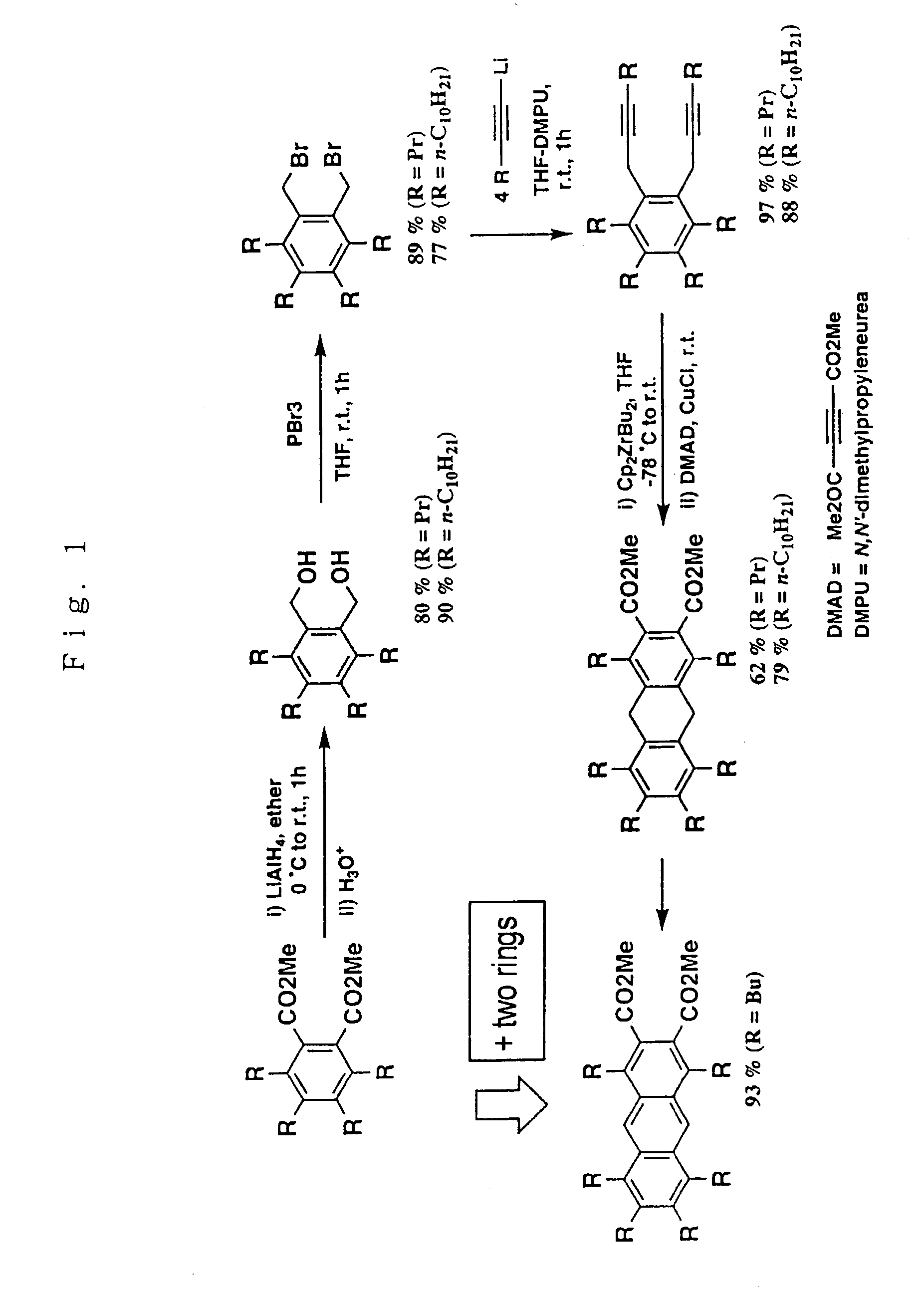Polyacene derivatives and production thereof
a technology of polyacenes and derivatives, applied in the field of polyacene derivatives, can solve the problems of difficult formation of thin films, poor solubility of condensed polycyclic aromatic compounds such as polyacenes, and difficulty in forming thin films, etc., to achieve the effect of improving solubility, easy synthesis and improving solubility
- Summary
- Abstract
- Description
- Claims
- Application Information
AI Technical Summary
Benefits of technology
Problems solved by technology
Method used
Image
Examples
reference example 1
Dimethyl 1,4,5,6,7,8-hexapropyl-9,10-dihydroanthracene-2,3-dicarboxylate
[0656]Bis(η5-cyclopentadienyl)dichlorozirconium (1.2 mmol) and THF (10 ml) were charged in a Schlenk tube. This solution was cooled to −78° C., and n-butyl lithium (2.4 mmols) was then added to the solution. The solution was stirred at −78° C. for an hour to give bis(η5-cyclopentadienyl)dibutylzirconium.
[0657]After 1,2-bis(2-hexynyl)-3,4,5,6-tetrapropylbenzene (1.0 mmol) was added to the reaction mixture at −78° C., the mixture was warmed to room temperature and allowed to stand for an hour to give 1-zirconacyclopenta-2,4-diene derivative.
[0658]To a solution of the thus obtained 1-zirconacyclopenta-2,4-diene (1.0 mmol) derivative in THF (10 ml), CuCl (2.0 mmols) and dimethyl acetylenedicarboxylate (3.0 mmols) were added followed by stirring at room temperature for an hour. Then, the reaction was quenched with 3N hydrochloric acid. Next, the reaction mixture was extracted with diethyl ether, and washed with sodiu...
reference example 2
[0660]
Dimethyl 1,4,5,6,7,8-hexapropylanthracene-2,3-dicarboxylate
[0661]Dimethyl 1,4,5,6,7,8-hexapropyl-9,10-dihydroanthracene-2,3-dicarboxylate obtained in REFERENCE EXAMPLE 1 was used. 2,3-Dichloro-5,6-dicyanobenzo-quinone (0.729 g, 3.21 mmols) was added to a solution of dimethyl 1,4,5,6,7,8-hexapropyl-9,10-dihydroanthracene-2,3-dicarboxylate (1.554 g, 2.832 mmols) in benzene (25 ml). Subsequently, the mixture was refluxed for an hour. After filtration, the solvent in the mixture was removed in vacuum. Hexane was added to disintegrate into powders, whereby 1.393 g of the title compound was obtained as a white solid. The isolation yield was 90%.
[0662]1H NMR (CDCl3, Me4Si) δ 1.13 (t, J=7.2 Hz, 6H), 1.14 (t, J=7.3 Hz, 6H), 1.21 (t, J=7.3 Hz, 6H), 1.60-1.66 (m, 4H), 1.76-1.91 (m, 8H), 2.80 (t, J=8.3 Hz 4H), 3.14-3.23 (m, 8H), 3.93 (s, 6H), 8.82 (s, 2H); 13C NMR (CDCl3, Me4Si) δ 14.77 (2C), 15.01 (2C), 15.03 (2C), 24.61 (2C), 24.74 (2C), 24.88 (2C), 31.69 (2C), 32.71 (2C), 32.81 (2C), 5...
reference example 3
[0663]
2,3-Bis(hydroxymethyl)-1,4,5,6,7,8-hexapropylanthracene
[0664]Dimethyl 1,4,5,6,7,8-hexapropylanthracene-2,3-dicarboxylate obtained in REFERENCE EXAMPLE 2 was used. After lithium aluminum hydride was added to the solution of dimethyl 1,4,5,6,7,8-hexapropylanthracene-2,3-dicarboxylate in diethyl ether at 0° C., the mixture was warmed to room temperature and stirred for an hour. At room temperature, water was added to terminate the reaction. Next, the reaction mixture was rendered slightly acidic with 2N sulfuric acid and extracted with ether. After washing with brine, the extract was dried over anhydrous magnesium sulfate. Column chromatography with silica gel as the packing material was performed using hexane. Recrystallization from hexane gave 6.637 g (13.846 mmols) of the title compound as a light yellow solid. The isolation yield was 98%.
[0665]1H NMR (CDCl3, Me4Si) δ 1.11-1.26 (m,18H), 1.58-1.68 (m, 4H), 1.74-1.81 (m, 8H), 2.78 (t, J=8.3 Hz, 4H), 3.15 (t, J=8.3 Hz, 4H), 3.26 ...
PUM
| Property | Measurement | Unit |
|---|---|---|
| Fraction | aaaaa | aaaaa |
| Fraction | aaaaa | aaaaa |
| Time | aaaaa | aaaaa |
Abstract
Description
Claims
Application Information
 Login to View More
Login to View More - R&D
- Intellectual Property
- Life Sciences
- Materials
- Tech Scout
- Unparalleled Data Quality
- Higher Quality Content
- 60% Fewer Hallucinations
Browse by: Latest US Patents, China's latest patents, Technical Efficacy Thesaurus, Application Domain, Technology Topic, Popular Technical Reports.
© 2025 PatSnap. All rights reserved.Legal|Privacy policy|Modern Slavery Act Transparency Statement|Sitemap|About US| Contact US: help@patsnap.com



